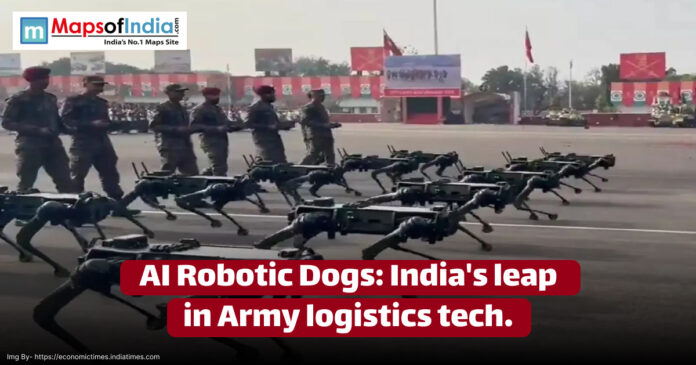Long regarded as the world‘s land of techies and engineers, India makes waves as a rising power in deploying artificial intelligence (AI) across key sectors, including defence. One of the most interesting innovations in this space is the inducement of AI-powered robotic dogs. This new technology could bring as much as 99% improvement in army logistics and operation efficiency in the not-too-distant future as these advanced machines become a reality. This article discusses how these robotic dogs are being deployed, what they bring to the table, and the difficulties in deploying them, so you can get a comprehensive view of this emerging frontier.
The Rise of AI-Powered Robotic Dogs
Robot dogs aren’t an entirely new concept. Right from the beginning, Boston Dynamics-era iconic quadrupedal robot, the ”Spot” was ground-breaking. India’s interest in such robotic platforms is unique because it wants to modify the technology for its own operational and logistical needs. Harnessing the power of AI, machine learning, and robotics, these robotic dogs can do tasks that can supplement and amplify human activity.
DRDO and private companies in India have developed indigenous designs in robotic systems over the past few years. These are intelligent machines, autonomous and smart machines that can navigate without a hazard, detour from an obstacle, carry a payload, and decide in real-time. They have their sector of walking troops and are useful for the Indian Army in difficult terrain and high-risk work areas.
Uses of Army Logistics
Logistics — the backbone of any military operation — is just one of the main functions of these robotic dogs. Logistics helps to get crucial materials (such as food, ammunition, and medical supplies) to soldiers based in remote or hostile environments promptly. Here is how such AI-based robotic dogs are changing this segment:
-
Moving Materials in Challenging Terrain
India’s varied geography — with mountainous, forested and desert terrain — creates logistical challenges. Robotic dogs, with their versatility to walk over rocks and avoid falling, provide a much better solution. They can carry sizable payloads, delivering supplies to troops in areas that cannot be accessed by traditional vehicles.
-
Minimizing Human Exposure in Dangerous Areas
Sending personnel to deliver supplies in conflict zones or in places filled with landmines and IED (Improvised Explosive Devices) is dangerous — with AI algorithms and sensors, robotic dogs can do this in places where a human- or vehicle-driven approach may be more challenging, making it less risky for human life.
-
Observation and Investigation
These robots can be used for surveillance missions, in addition to logistics. These are equipped with cameras, thermal imaging and night-vision capability to collect intelligence and transmit critical information in real-time to any command centre to make a decision.
-
Emergency Response
Robotic dogs are said to be a saviour of human life during natural disasters and at safeguarded battlefields. Their skill at finding survivors and delivering lifesaving medical supplies in rubble saves lives.
Technological Features
The technological complexity of AI-powered robotic dogs is the secret behind their efficiency:
- Autonomous Navigation: Advanced AI algorithms enable these robots to chart their course and navigate obstacles autonomously.
- Payload Capacity: Robotic dogs can carry anything between a few and a few dozen kilograms depending on the model, which is useful for a wide range of logistical tasks.
- Durability: These robots are constructed with tough materials that can endure rough handling and severe weather.
- Communication System: They are integrated with secure communication systems to provide feedback information to operators or command centres.
- Energy Efficiency: Most models also allow for intensive daily usage, some like solar charging.
Benefits for the Indian Army
-
Improved Productivity
This is where another popular machine, namely robotic dogs, can come in handy to make working logistics more efficient and better adapted to deliver supplies on time and with significantly less manpower. It frees soldiers to concentrate on their primary operational responsibilities.
-
Cost-Effectiveness
Although the upfront cost of these AI-based robotic canines may be high, in the long run, they reduce the amount of overarching expenses in maintaining a vehicle, as well as reducing the number of casualties during a dangerous operation.
-
Scalability
Such robots may be used by thousands together, and at varied landscapes, offering a scalable solution for varied military applications.
-
Technological Edge
With the induction of this cutting-edge technology, the Indian Army positions itself as a modern, technology-led force that is at par with global military trends.
Challenges and Concerns
The promise sounds great, but the cosmetic use of AI-powered robotic dogs has its challenges:
- High price: The initial investment to develop and purchase these machines is very high.
Technical constraints: Problems with electric batteries, operating range and vulnerability against hacking are still in question. - Ethical Concerns: The use of AI in the military is another issue that raises many ethical questions, particularly concerning who is responsible for this technology and if it can be misused when applied as autonomous devices.
- Training Constraint: The implementation and integration of such technology is a big ask of militaries as well, as militaries would need to undergo repainting of old training and operational frameworks to host such tech.
- Over-Reliance on Technology: Heavy reliance on robotic systems can lead to challenges if these machines malfunction or hack.
Future Prospects
But it is AI-powered robotic dogs that process and attempt to act on this large amount of data that perhaps tell the most telling story about India’s overriding objectives of modernising defence strategy. Working with the government, however, leaves initiatives such as the “Make in India” policy to once again underscore the need to take the long view, and develop indigenized solutions that ensure technology has our national security needs at heart. These robotic dogs are the start, with ongoing enhancements in design, functionality, and AI capabilities to come. Advances in sensors, materials, and machine learning algorithms could produce models that are cheaper, more durable, and more versatile. These breakthroughs may be aided by partnerships with global robotics and AI leaders.
Moreover, the robotic dog could be the physical extension of such drone and satellite systems within the battlefield, thereby forming a network where these individual units can collaborate and maximize the efficiency of the logistical and operational network that can be created. These developments can increase military effectiveness but have civilian uses in disaster response, industrial logistics and other areas as well.
Conclusion
The Indian use of AI-driven robotic dogs would take technology in defence and logistics to the next level. Such gadgets enhance their operational value and lower the risk to human operators. Though challenges remain, from the developmental and integration perspectives, this is indicative of the intent and future direction of India’s evolution as a 21st-century innovator fighting force and logistics contributor.
While the world envisions technological India, AI-backed robotic dogs are no longer these visions. These are hard applications that can transform not just the military logistics realm but also the use of robotics in general in society. With sustained efforts and strategic investments, India has the potential to become a pioneer in this transformative sector.





